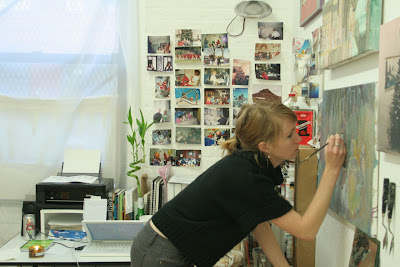Transcending, 24 x 24", oil on wood, 2012-2013
What are you working on in your studio right now?
Can you describe your working routine?
I have days that I am in the studio, days that I am teaching, and days that I’m doing the business end of art, so I don’t know if I have an actual routine. If it is a studio day, I am in there in the morning and usually start with straightening up and figuring out what I am going to work on. It is a warm up time. I have concentrated bursts of focused time. I have never been one to paint for hours on end, yet the time I spend making serves me well. Working on many pieces at a time allows me such freedom not to think and just make. Recently a friend of mine joked that I can make a painting in a day. I laughed. I am happy that my work appears to be so fresh and alive but one day does not create a painting. I have been focusing on not overworking my paintings so stopping and starting again is key to their development. There is a huge gestation time for most pieces. They sit around for weeks, or months until I get back to them and know how to “resolve” them. I always have multiple paintings around in various stages. Most of the work is done in a series and the paintings converse with each other, yet each piece is a completed idea and image on its own. For me, working in a series helps to expand the image idea making and keeps the work fresh.
"There are numerous paintings “percolating”
around in stacks and on the walls today."
Can you describe your studio space and how, if at all, that affects your work?
I am working in my garage, which is a good space in the spring and summer but is pretty cold in the winter. I like that my studio is attached to my house but has a separate entrance. However, I do not have much natural light and look forward to a studio with big windows and some space. I am slowly outgrowing my space.
My working routine and process are pretty close. I am at a point in my art making where I feel I have my tool belt pretty well stocked with a vocabulary, ideas, materials, and inspirations. I try to trust that and stay out of my own way. Work begins as play, play with great freedom and without judgment. Evolution comes from looking and paying careful, intuitive attention to what is happening in the work. If I am listening, my work tells me my story. My visual memory and interpretation of the world are more perceptive and in tune than my intellect. I believe in the idea of the spiral. Images and ideas that I have investigated in the past reappear again and again in a different form at different times. I have found my photographs to be very helpful, not as something to work from, but as an indicator of how I see the world. The most important part of my process is looking, editing and of course, deciding when a painting is done. One of my favorite times is coming back to the studio after a day of working to see the work again in a new light.
Untitled, 11 x11", mixed media on mylar 2012
Untitled, 11 x11", mixed media on mylar 2012
What are you having the most trouble resolving?
I have trouble having faith in my process. Although I understand the way I work, I have to fight the doubts, judgments and feelings of that not being enough. This is resolved by just being able to move forward and continue working, and trusting that “not knowing,” which is the place I visit all the time in my work, is “knowing” in my world.
Do you experiment with different materials a lot or do you prefer to work within certain parameters?
I come from experimenting with many materials. I have used clay, wood, nails, paper mache, pastels, charcoal, acrylic, oil, cold wax and encaustic throughout the years. Right now I am working on oil and cold wax pieces, encaustic paintings that include collage, ink and pastel and a series with graphite on vellum.
I enjoy the characteristics’ of each medium and switching it up activates different approaches. For me working with encaustic allows for a very quick build up of layers and many possibilities for scraping and excavating into the work, but it is a very focused intense process. When I paint with oils I have an expansive experience. There is expressiveness to the application of the paint and the moving around it is exciting. Lately I have been using scrapers, brayers, tools and monoprinting to move and mark with the paint. I am working on a new grouping drawings on vellum. Working with graphite, erasers, pastels is liberating as a visual thinking process.
I enjoy the characteristics’ of each medium and switching it up activates different approaches. For me working with encaustic allows for a very quick build up of layers and many possibilities for scraping and excavating into the work, but it is a very focused intense process. When I paint with oils I have an expansive experience. There is expressiveness to the application of the paint and the moving around it is exciting. Lately I have been using scrapers, brayers, tools and monoprinting to move and mark with the paint. I am working on a new grouping drawings on vellum. Working with graphite, erasers, pastels is liberating as a visual thinking process.
The Dark, 8 x6”, oil on board, 2013
What does the future hold for this work?
Is there anything else you would like to add?
Thanks, Valerie, for this opportunity to talk about my current work and process!
Spirit Bag 3, oil on wood, 24 x 24", 2013






























